Tuesday, December 18, 2012




December 18 - Bethlehem
“But thou, Bethlehem … though thou be little among the thousands of Judah, yet out of thee shall he come forth unto me that is to be ruler in Israel; whose goings forth have been from of old, from everlasting.” (Micah 5:2.)
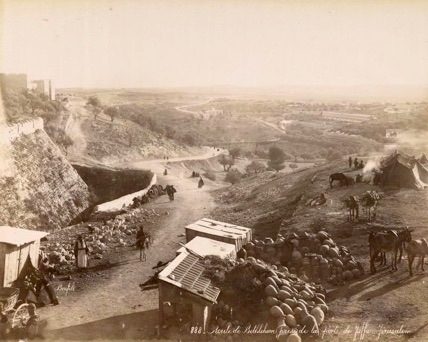
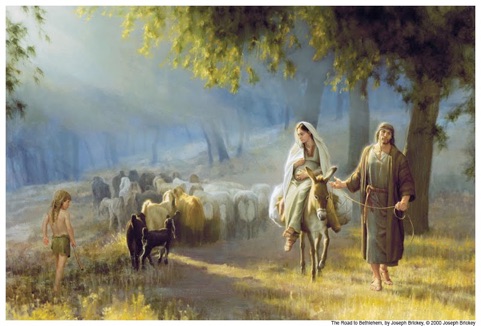
The Road to Bethlehem, by Joseph Brickey
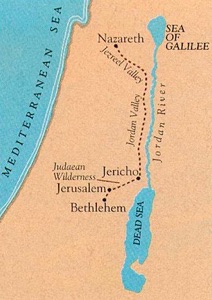
Complete Devotionals HERE.

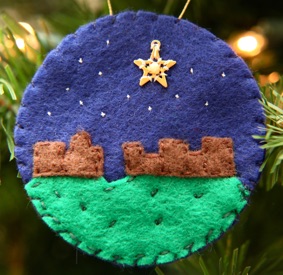
Opening Song: In A Little Stable-piano; vocal copy
Have the children ring bells while singing.
Ornament: Bethlehem
“Both of the routes they could have taken are about 92 miles long. Normal walking pace, even with a camel or donkey, is 3 miles per hour. So a traveler can usually walk between 17 and 24 miles each day. Each route takes about 30 hours to walk—17 to 20 miles a day for 5 days. At that rate, the journey would have taken Joseph and Mary at least 4 to 5 days. We wonder where they stayed each night, where and with whom they camped along the way. It would have been a wearying journey for anyone, but especially for a pregnant woman soon to give birth. It was early spring, which can still be very chilly at night in the hill country. However, in the Jordan Valley—which is below sea level—the temperatures would have been mild and pleasant.”1
Julie’s awesome Bethlehem ornament
I sewed mine from felt pieces and attached a star pendant.
The prophet Micah foretold: “But thou, Bethlehem … though thou be little among the thousands of Judah, yet out of thee shall he come forth unto me that is to be ruler in Israel; whose goings forth have been from of old, from everlasting.” (Micah 5:2.)
In the Book of Mormon, Alma also foretold the birthplace of the Savior 83 years before it happened: “And behold, he shall be born of Mary, at Jerusalem which is the land of our forefathers, she being a virgin, a precious and chosen vessel, who shall be overshadowed and conceive by the power of the Holy Ghost, and bring forth a son, yea, even the Son of God” (Alma 7:10).
“When the angel Gabriel appeared to Mary, she was living in Nazareth. Yet, it was prophesied that the promised Messiah would be born in Bethlehem of Judaea. So how could the prophecy of the birth be fulfilled in Bethlehem—nearly one hundred miles away? Surely it was not by chance that Roman administrators decided to conduct an enrollment for the purpose of taxation, which sent thousands throughout the country back to their ancestral hometowns. Joseph and Mary had to set out on an arduous journey southward to Bethlehem.” 1 The scriptures say, “And Joseph also went up from Galilee, out of the city of Nazareth, into Judaea, unto the city of David, which is called Bethlehem; (because he was of the house and lineage of David:) To be taxed with Mary his espoused wife, being great with child” (Luke 2:4–5).
Even in the journey to bring the unborn Christ child to His birthplace, the mother who carried Him, and His faithful guardian Joseph descended physically below all places on the earth, descending into the desert of Jericho, one of the lowest points on earth. “The last leg of the eastern route would have been the hardest of all. Jericho is the lowest city on the globe, and Jerusalem and Bethlehem are situated right in the top of the hills. From Jericho’s desert to Bethlehem is an uphill hike of 3,500 feet. How exhausted Mary must have been! How anxious Joseph must have been to find a comfortable room at the inn! Desperate to find adequate shelter, they may have resorted at last to a limestone cave used for a stable.” 1
“Since Jesus created the earth, He could have chosen to live anywhere. He could have selected the beautiful islands of the sea with their lush vegetation and breathtaking beauty. He could have chosen the scenery of Switzerland or Scandinavia, or He could have preferred to walk upon the acres of Africa or Australia. Instead, He selected a land with places stark and arid (bare and dry). Why would He choose that exact location? He chose the land around Jerusalem for many reasons. Jesus loved to teach using examples the people could see around them – like the geography of their land and the types of people who lived there (he used olive trees and fig trees to teach lessons, and gave parables of a sower, a servant, laborers in a field, sheep and goats, vines and branches).”2
Isaiah prophesied, “For he shall grow up before him as a tender plant, and as a root out of a dry ground: he hath no form nor comeliness; and when we shall see him, there is no beauty that we should desire him” Isaiah 53:2. Jesus declared himself to be “the root and the offspring of David” (Rev. 22:16). Jesus, this “root,” grew up in David’s homeland, a place that literally had dry ground and was filled with people who were figuratively “spiritually dry” or wicked.2
In Hebrew, Bethlehem means “house of bread”. In John 6:48, Jesus said, “I am that bread of life.” Isn’t it neat that the “Bread of Life” was born in the “house of bread”? And when do we eat bread in remembrance of Jesus? (sacrament) Every time we partake of that “bread of life” we are spiritually born again.
“After millennia of preparation, the long awaited event occurred. Christ was born among men. No wonder angelic choirs sang as they knew that extended centuries of death and darkness were to be relieved by the Atonement, which was finally to come through this Babe of Bethlehem.” 2
As we see this Bethlehem ornament, we should remember its significance as the “house of bread” where the Lamb of God, the bread of life was brought forth by miraculous events into His mortal existence. During the sacrament, we can renew our covenant with Him and be spiritually reborn each week.
Closing Song: “If I Had Been in Bethlehem” by Sally DeFord or “Come to Bethlehem” (Friend, Dec. 2007)
1“The Road to Bethlehem” by D. Kelly Ogden, Ensign, Dec. 1995, 13.
2“Why This Holy Land?” By Elder Russell M. Nelson, Ensign, Dec. 1989, 13
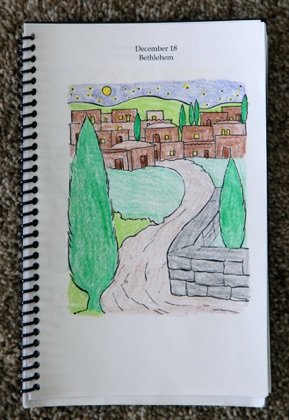
Activity Idea from Jessica Ragsdale: Since we are talking about “Houses of Bread” make a little town of Bethlehem out of yummy gingerbread.
Extra: Watch “Mary and Joseph Travel to Bethlehem” (2:05).
